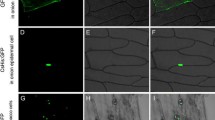Abstract
The Oct motif (CGCGGATC) is highly conserved in plant histone gene promoters. Three types of Oct-containing composite elements have been identified: type I element composed of Hex and reverse-oriented Oct (CCACGTCAN CGATCCGCG), type II element with a 3-bp extension of conservation (TCACGCGGATC), and type III element with a CCAAT-containing sequence (CCAAT-box) as the other module (GATCCGCG-(N)14-ACCAATCA). Gain-of-function experiments with transgenic tobacco cell lines showed that each of the three types of Oct-containing elements can confer the ability to direct S phase-specific expression on a heterologous promoter. In transgenic plants, the type I and III elements activated transcription in tissues with high meristematic activity, whereas the activity of the type II element was only detected in young guard cells. For both S phase-specific and tissue-specific expression, the cooperation of Oct and the other module (Hex, TCA, or CCAAT-box) was absolutely required. Thus, Oct plays a pivotal role in regulation of the expression of plant histone genes.
Similar content being viewed by others
References
Atanassova, R., Chaubet, N. andGigot, C. 1992. A 126 bp fragment of a plant histone gene promoter confers preferential expression in meristems of transgenicArabidopsis. Plant J.2: 291–300.
Brignon, P. andChaubet, N. 1993. Constitutive and cell-division-inducible protein-DNA interactions in two maize histone gene promoters. Plant J.4: 445–457.
Chaubet, N., Flénet, M., Clément, B., Brignon, P. andGigot, C. 1996. Identification ofcis-elements regulating the expression of anArabidopsis histone H4 gene. Plant J.10: 425–435.
Crane-Robinson, C. 1997. Where is the globular domain of linker histone located on the nucleosome? Trends Biochem. Sci.22: 75–77.
de Vetten, N.C. andFerl, R.J. 1994. Transcriptional regulation of environmentally inducible genes in plants by an evolutionary conserved family of G-box binding factors. Int. J. Biochem.26: 1055–1068.
Foster, R., Izawa, T. andChua, N.H. 1994. Plant bZIP proteins gather at ACGT elements. FASEB J.8: 192–200.
Heintz, N. 1991. The regulation of histone gene expression during the cell cycle. Biochim. Biophys. Acta1088: 327–339.
Huh, G.H., Nakayama, T., Meshi, T. andIwabuchi, M. 1997. Structural characteristics of two wheat histone H2A genes encoding distinct types of variants and functional differences in their promoter activity. Plant Mol. Biol.33: 791–802.
Iwabuchi, M., Nakayama, T. andMeshi, T. 1998. Transcriptional control of histone genes.In D. Francis, D. Dudits and D. Inzé, eds., Plant Cell Division, Portland Press Ltd., London, pp. 285–300.
Kawata, T., Nakayama, T., Mikami, K., Tabata, T., Takase, H. andIwabuchi, M. 1988. DNA-binding protein(s) interacts with a conserved nonameric sequence in the upstream regions of wheat histone genes. FEBS Lett.239: 319–323.
Lepetit, M., Ehling, M., Atanassova, R., Chaubet, N. andGigot, C. 1993. Replication-independent cis-acting element of a maize histone gene promoter. Plant Sci.89: 177–184.
Meshi, T. andIwabuchi, M. 1995. Plant transcription factors. Plant Cell Physiol.36: 1405–1420.
Mikami, K. andIwabuchi, M. 1993. Regulation of cell cycle-dependent gene expression.In D.P.S. Verma, ed., Control of Plant Gene Expression, CRC Press, Boca Raton, pp. 51–68.
Nakayama, T., Sakamoto, A., Yang, P., Minami, M., Fujimoto, Y., Ito, T. andIwabuchi, M. 1992. Highly conserved Hexamer, octamer and nonamer motifs are positivecis-regulatory elements of the wheat histone H3 gene. FEBS Lett.300: 167–170.
Ohtsubo, N., Nakayama, T., Terada, R., Shimamoto, K. andIwabuchi, M. 1993. Proximal promoter region of the wheat histone H3 gene confers S phase-specific gene expression in transformed rice cells. Plant Mol. Biol.23: 553–565.
Ohtsubo, N., Nakayama, T., Kaya, H., Terada, R., Shimamoto, K., Meshi, T. andIwabuchi, M. 1997. Cooperation of two distinct cis-acting elements is necessary for the S phase-specific activation of the wheat histone H3 promoter. Plant J.11: 1219–1225.
Osley, M.A. 1991. The regulation of histone synthesis in the cell cycle. Annu. Rev. Biochem.60: 827–861.
Reichheld, J.-P., Sonobe, S., Clément, B., Chaubet, N. andGigot, C. 1995. Cell cycle-regulated histone gene expression in synchronized plant cells. Plant J.7: 245–252.
Shen, W.H. andGigot, C. 1997. Protein complexes binding tocis elements of the plant histone gene promoters: multiplicity, phosphorylation and cell cycle alteration. Plant Mol. Biol.33: 367–379.
Taoka, K., Ohtsubo, N., Fujimoto, Y., Mikami, K., Meshi, T. andIwabuchi, M. 1998. The modular structure and function of the wheat H1 promoter with S phase-specific expression. Plant Cell Physiol.39: 294–306.
Terada, R., Nakayama, T., Iwabuchi, M. andShimamoto, K. 1993. A wheat histone H3 promoter confers cell division-dependent and-independent expression of thegusA gene in transgenic rice plants. Plant J.3: 241–252.
Terada, R., Nakayama, T., Iwabuchi, M. andShimamoto, K. 1995. A type I element composed of the hexamer (ACGTCA) and octamer (CGCGGATC) motifs plays a role(s) in meristematic expression of a wheat histone H3 gene in transgenic rice plants. Plant Mol. Biol.27: 17–26.
van Holde, K.E. 1989. Chromatin. Springer-Verlag, New York.
Wolffe, A. 1995. Chromatin. Structure and Function (second edition). Academic Press, London.
Yang, P., Taoka, K., Nakayama, T. andIwabuchi, M. 1995. Structural and functional characterization of two wheat histone H2B promoters. Plant Mol. Biol.28: 155–172.
Author information
Authors and Affiliations
Rights and permissions
About this article
Cite this article
Meshi, T., Taoka, Ki. & Iwabuchi, M. S phase-specific expression of plant histone genes. J. Plant Res. 111, 247–251 (1998). https://doi.org/10.1007/BF02512178
Received:
Accepted:
Issue Date:
DOI: https://doi.org/10.1007/BF02512178




